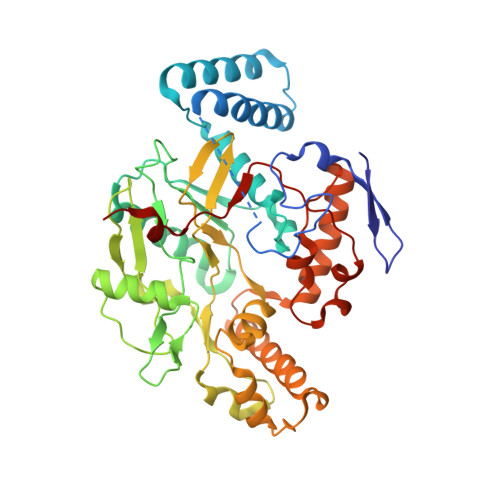Mobility of a Conserved Tyrosine Residue Controls Isoform-Dependent Enzyme-Inhibitor Interactions in Nitric Oxide Synthases.
Li, H., Jamal, J., Delker, S.L., Plaza, C., Ji, H., Jing, Q., Huang, H., Kang, S., Silverman, R.B., Poulos, T.L.(2014) Biochemistry 53: 5272
- PubMed: 25089924
- DOI: https://doi.org/10.1021/bi500561h
- Primary Citation of Related Structures:
4CWV, 4CWW, 4CWX, 4CWY, 4CWZ, 4CX0, 4CX1, 4CX2, 4CX3, 4CX4, 4CX5, 4CX6, 4CX7 - PubMed Abstract:
Many pyrrolidine-based inhibitors highly selective for neuronal nitric oxide synthase (nNOS) over endothelial NOS (eNOS) exhibit dramatically different binding modes. In some cases, the inhibitor binds in a 180¡ă flipped orientation in nNOS relative to eNOS. From the several crystal structures we have determined, we know that isoform selectivity correlates with the rotamer position of a conserved tyrosine residue that H-bonds with a heme propionate. In nNOS, this Tyr more readily adopts the out-rotamer conformation, while in eNOS, the Tyr tends to remain fixed in the original in-rotamer conformation. In the out-rotamer conformation, inhibitors are able to form better H-bonds with the protein and heme, thus increasing inhibitor potency. A segment of polypeptide that runs along the surface near the conserved Tyr has long been thought to be the reason for the difference in Tyr mobility. Although this segment is usually disordered in both eNOS and nNOS, sequence comparisons and modeling from a few structures show that this segment is structured quite differently in eNOS and nNOS. In this study, we have probed the importance of this surface segment near the Tyr by making a few mutants in the region followed by crystal structure determinations. In addition, because the segment near the conserved Tyr is highly ordered in iNOS, we also determined the structure of an iNOS-inhibitor complex. This new structure provides further insight into the critical role that mobility plays in isoform selectivity.
Organizational Affiliation:
Departments of Molecular Biology and Biochemistry, Pharmaceutical Sciences, and Chemistry, University of California , Irvine, California 92697-3900, United States.





















